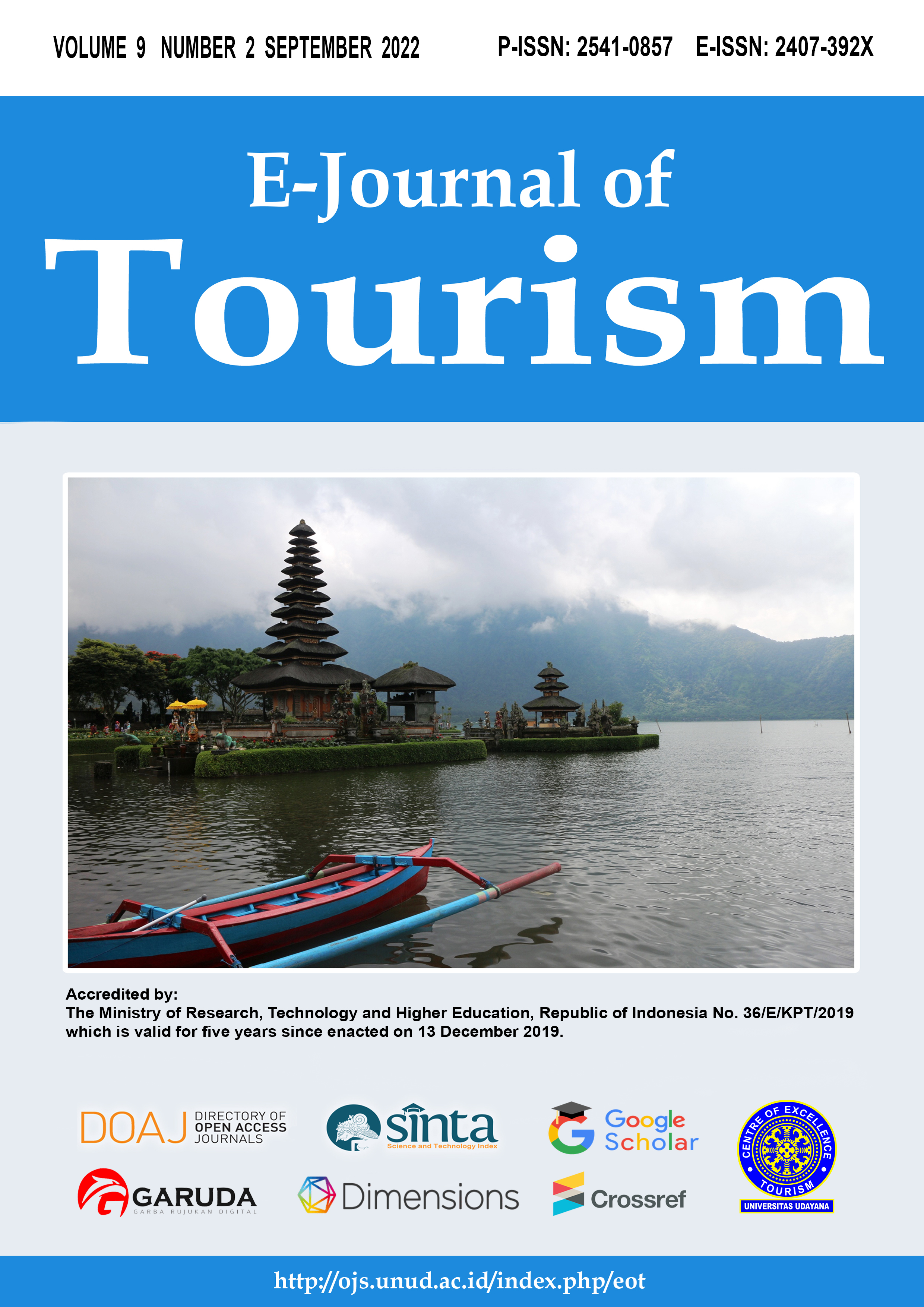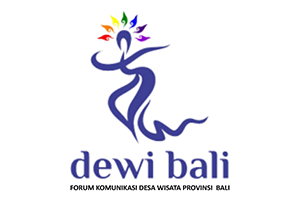Planning of Gastronomic Tourism Destinations in Balikpapan City
Abstract
Planning the development of food-related tourist destinations often ignores the expectations of tourists themselves. This phenomenon almost occurs in various regions in Indonesia, especially in Balikpapan City. The purpose of this study is to analyze the planning of gastronomic tourism destinations from the tourists' perspective. This research was conducted using a descriptive survey method to determine the expectations of tourists visiting Manggar Beach in Balikpapan City regarding the gastronomic aspect. Data collection was carried out in April–June 2022 using an online questionnaire (google form), which was distributed to 117 respondents. The results of data collection were analyzed using SPSS 21.0 descriptively (frequency, arithmetic mean, and standard deviation). The scale of validity and reliability was measured. Research findings show that the gastronomy offered by culinary centers is less varied, most 76.9% of visitors have the habit of bringing raw food ingredients and cooking independently, 15.4% brought food and beverages from home, and 7.7% bought those available at culinary centers. Most of the visitors rated the satisfaction variable indicator in the unfavorable category, the lowest average value was Y2 (x? = 1.82, SD= 0.38) and the highest mean Y8 (x? = 2.50, SD = 0.76).
Keywords: gastronomy; gastro tourism; destination planning; tourist expectations.
Downloads
References
Ali, F., Ryu, K., & Hussain, K. (2016). Influence of Experiences on Memories, Satisfaction and Behavioral Intentions: A Study of Creative Tourism. Journal of Travel & Tourism Marketing, 33(1), 85–100. https://doi.org/10.1080/10548408.2015.1038418
Ayu, G., Hendriyani, D., Gusti, I., Dewi Hendriyani, A., Antara, M., & Sudiarta, N. (n.d.). The Loyalty Model of Foreign Tourists Consuming Traditional Balinese Food. GLOBAL BUSINESS & FINANCE REVIEW, 34–48. https://doi.org/10.17549/gbfr.2020.25.3
Blomstervik, I. H., Prebensen, N. K., Campos, A. C., & Pinto, P. (2021). Novelty in tourism experiences: the influence of physical staging and human interaction on behavioural intentions. Current Issues in Tourism, 24(20), 2921–2938. https://doi.org/10.1080/13683500.2020.1854197
Carpio, N. M., Napod, W., & Do, H. W. (2021). Gastronomy as a factor of tourists’ overall experience: a study of Jeonju, South Korea. International Hospitality Review, 35(1), 70–89. https://doi.org/10.1108/ihr-08-2020-0031
Ellis, A., Park, E., Kim, S., & Yeoman, I. (2018). What is food tourism? In Tourism Management (Vol. 68, pp. 250–263). Elsevier Ltd. https://doi.org/10.1016/j.tourman.2018.03.025
Kim, S., Park, E., Fu, Y., & Jiang, F. (2021). The cognitive development of food taste perception in a food tourism destination: A gastrophysics approach. Appetite, 165. https://doi.org/10.1016/j.appet.2021.105310
Pamukçu, H., Saraç, Ö., Aytuğar, S., & Sandıkçı, M. (2021). The effects of local food and local products with geographical indication on the development of tourism gastronomy. Sustainability (Switzerland), 13(12). https://doi.org/10.3390/su13126692
Pérez Gálvez, J. C., López-Guzmán, T., Cordova Buiza, F., & Medina-Viruel, M. J. (2017). Gastronomy as an element of attraction in a tourist destination: the case of Lima, Peru. Journal of Ethnic Foods, 4(4), 254–261. https://doi.org/10.1016/J.JEF.2017.11.002
Purwanto, A. (2022, April 29). Kota Balikpapan: Dari Kampung Nelayan Menjadi Kota Penyangga Ibu Kota Baru Nusantara. Kompas.Com. https://www.kompas.id/baca/daerah/2022/04/29/kota-balikpapan-dari-kampung-nelayan-menjadi-kota-penyangga-ibu-kota-baru-nusantara
Putri, D. (2022, May 5). Libur Lebaran, PAD Pantai Manggar di Kota Minyak Sudah Capai Rp 200 Juta. Suarakaltim.Id. https://kaltim.suara.com/read/2022/05/05/145631/libur-lebaran-pad-pantai-manggar-di-kota-minyak-sudah-capai-rp-200-juta
Ranteallo, I. C., & Andilolo, I. R. (2017). Food Representation and Media: Experiencing Culinary Tourism Through Foodgasm and Foodporn. In Balancing Development and Sustainability in Tourism Destinations (pp. 117–127). Springer Singapore. https://doi.org/10.1007/978-981-10-1718-6_13
Sugiyono. (2017). Metode Penelitian Pendidikan Pendekatan Kuantitatif, Kualitatif, dan R & D (26th ed.). Alfabeta.
Sunarto, H., & Riduwan. (2017). Pengantar Statistika untuk Penelitian Pendidikan, Sosial, Ekonomi, Komunikasi (9th ed.). Alfabeta.
The World Food Travel Association. (2019). What is Food Tourism? – World Food Travel Association. https://worldfoodtravel.org/what-is-food-tourism/
Tsai, C. T. S., & Wang, Y. C. (2017). Experiential value in branding food tourism. Journal of Destination Marketing & Management, 6(1), 56–65. https://doi.org/10.1016/J.JDMM.2016.02.003
Türker, N., & Süzer, Ö. (2022). Tourists’ food and beverage consumption trends in the context of culinary movements: The case of Safranbolu. International Journal of Gastronomy and Food Science, 27, 100463. https://doi.org/10.1016/j.ijgfs.2021.100463
Umar, H. (2003). Metode Riset Bisnis (2nd ed.). PT. Gramedia Pustaka Utama.
Wijayanti, A., & Damanik, J. (2019). Analysis of the tourist experience of management of a heritage tourism product: case study of the Sultan Palace of Yogyakarta, Indonesia. Journal of Heritage Tourism, 14(2), 166–177. https://doi.org/10.1080/1743873X.2018.1494182

This work is licensed under a Creative Commons Attribution 4.0 International License.
The copyright of the received article shall be assigned to the journal as the publisher of the journal. The intended copyright includes the right to publish the article in various forms (including reprints). The journal maintains the publishing rights to the published articles.




















